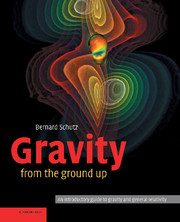Book contents
- Frontmatter
- Contents
- Preface
- Background: what you need to know before you start
- 1 Gravity on Earth:
- 2 And then came Newton
- 3 Satellites
- 4 The Solar System
- 5 Tides and tidal forces
- 6 Interplanetary travel
- 7 Atmospheres
- 8 Gravity in the Sun
- 9 Reaching for the stars
- 10 The colors of stars
- 11 Stars at work
- 12 Birth to death
- 13 Binary stars
- 14 Galaxies
- 15 Physics at speed
- 16 Relating to Einstein
- 17 Spacetime geometry
- 18 Einstein's gravity
- 19 Einstein's recipe
- 20 Neutron stars
- 21 Black holes
- 22 Gravitational waves
- 23 Gravitational lenses
- 24 Cosmology
- 25 The Big Bang
- 26 Einstein's Universe
- 27 Ask the Universe
- Appendix: values of useful constants
- Glossary
- Index
17 - Spacetime geometry
Finding out what is not relative
Published online by Cambridge University Press: 05 June 2012
- Frontmatter
- Contents
- Preface
- Background: what you need to know before you start
- 1 Gravity on Earth:
- 2 And then came Newton
- 3 Satellites
- 4 The Solar System
- 5 Tides and tidal forces
- 6 Interplanetary travel
- 7 Atmospheres
- 8 Gravity in the Sun
- 9 Reaching for the stars
- 10 The colors of stars
- 11 Stars at work
- 12 Birth to death
- 13 Binary stars
- 14 Galaxies
- 15 Physics at speed
- 16 Relating to Einstein
- 17 Spacetime geometry
- 18 Einstein's gravity
- 19 Einstein's recipe
- 20 Neutron stars
- 21 Black holes
- 22 Gravitational waves
- 23 Gravitational lenses
- 24 Cosmology
- 25 The Big Bang
- 26 Einstein's Universe
- 27 Ask the Universe
- Appendix: values of useful constants
- Glossary
- Index
Summary
When Einstein began to develop his theory of gravity, he knew he had to build on special relativity, but he felt strongly that he also had to preserve Galileo's other great contribution to physics, the principle of equivalence (Chapter 1). As with special relativity, Einstein worked by blending the old and the new in equal proportions: special relativity combined the old principle of relativity with the new principle of the universality of the speed of light; in his new theory of gravity Einstein combined the old principle of equivalence with his new theory of special relativity.
In this chapter: we take our first steps towards understanding general relativity by describing special relativity in terms of the geometry of four-dimensional spacetime. This geometry describes in an elegant and visual way the algebraic predictions of special relativity that we met in the previous chapters. The geometry of special relativity is flat, and we learn how the equivalence principle will allow us to curve it up and produce gravity.
▷ Underneath the text on this page is the familiar Mercator projection map of the entire Earth. This map illustrates strikingly the fact that the surface of the Earth cannot be represented faithfully on flat paper.
- Type
- Chapter
- Information
- Gravity from the Ground UpAn Introductory Guide to Gravity and General Relativity, pp. 211 - 224Publisher: Cambridge University PressPrint publication year: 2003

